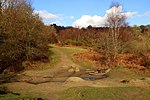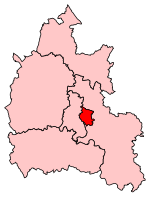Risinghurst
Risinghurst is an outlying residential area of Oxford, England, just outside the Eastern Bypass Road which forms part of the Oxford ring road. It is about 1 mile (1.6 km) east of the centre of Headington and 3 miles (4.8 km) east of Oxford city centre. It is part of the Risinghurst and Sandhills civil parish and is typical of housing estates built between the wars to house an increasingly prosperous working class who were moving into new urban centres—in this instance to take advantage of the burgeoning motor industry in Oxford.These estates offered decent housing, relatively sizeable gardens, a garage for a car and whilst Risinghurst isn't quite a garden city it has a sense of tranquillity (the countrification coming from the pebble-dash finish, the rough stone front wall, and a decent sized front garden where roses could be – and often were – grown). During the 1930s some 600 homes were built in sets of semi-detached units; two rows of shops were built on Downside Road and more at the end of Green Road in a stretch called The Roundway along with two pubs, a small library but neither a school nor, initially, a church. This left Risinghurst not quite a self-contained community and one that, by and large, was defined by 'The Works' (Morris Motors and Pressed Steel) that offered a broad range of amenities for their employees.
Excerpt from the Wikipedia article Risinghurst (License: CC BY-SA 3.0, Authors).Risinghurst
Downside Road, Oxford Risinghurst and Sandhills
Geographical coordinates (GPS) Address Nearby Places Show on map
Geographical coordinates (GPS)
| Latitude | Longitude |
|---|---|
| N 51.76 ° | E -1.19 ° |
Address
Downside Road 43
OX3 8HR Oxford, Risinghurst and Sandhills
England, United Kingdom
Open on Google Maps










